Публикации
2025
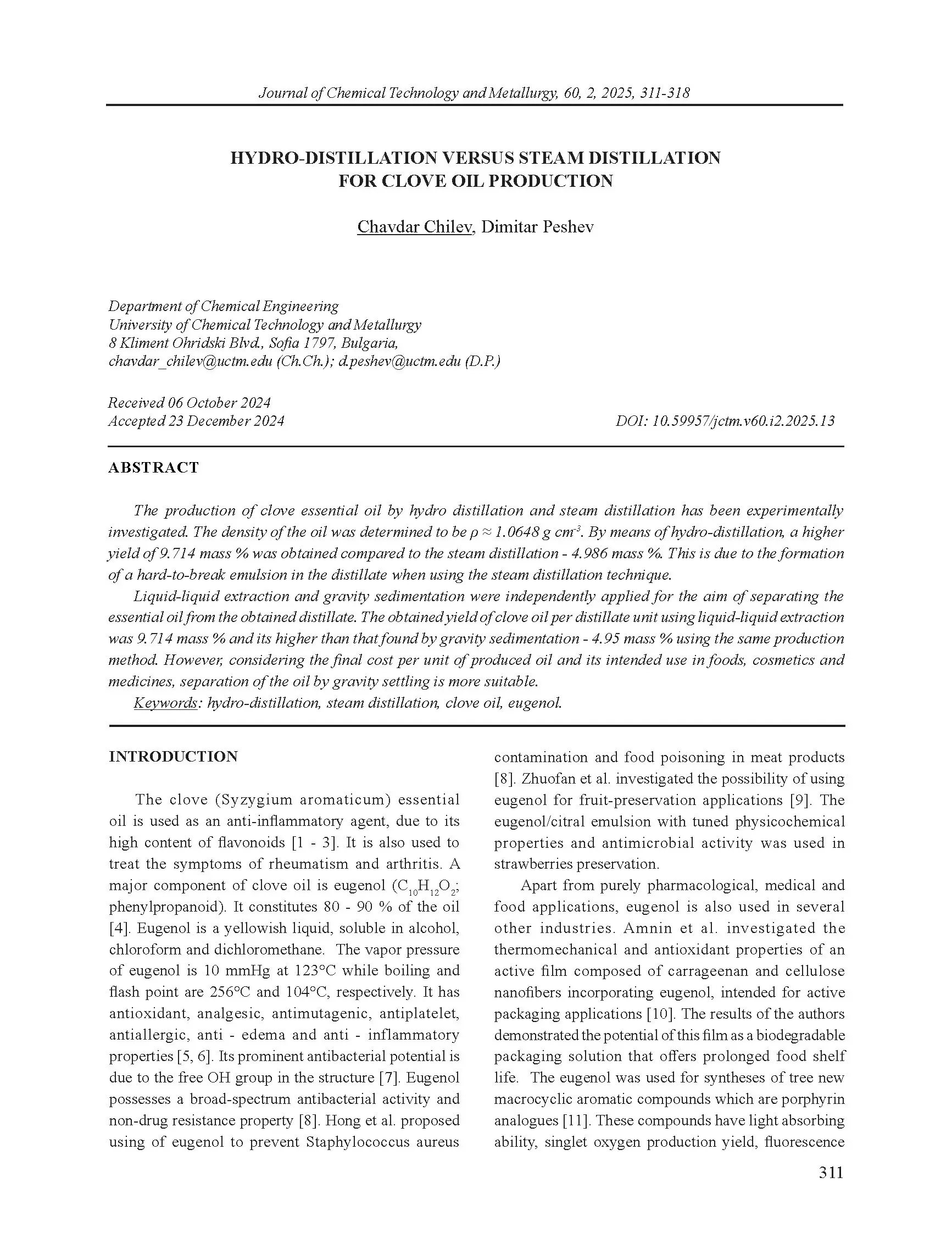
Chilev, Chavdar; Peshev, Dimitar
HYDRO-DISTILLATION VERSUS STEAM DISTILLATION FOR CLOVE OIL PRODUCTION Journal Article Forthcoming
In: Journal of Chemical Technology and Metallurgy, vol. 2, iss. 60, pp. 311-318, Forthcoming.
Abstract | Links | BibTeX | Етикети: Journal Article
@article{nokey,
title = {HYDRO-DISTILLATION VERSUS STEAM DISTILLATION FOR CLOVE OIL PRODUCTION},
author = {Chavdar Chilev and Dimitar Peshev},
url = {http://www.nanoessential.eu/wp-content/uploads/JCTM_2025_602_13_24-121_311-318-1.pdf},
doi = {10.59957/jctm.v60.i2.2025.13},
year = {2025},
date = {2025-01-26},
urldate = {2025-01-26},
journal = {Journal of Chemical Technology and Metallurgy},
volume = {2},
issue = {60},
pages = {311-318},
abstract = {The production of clove essential oil by hydro distillation and steam distillation has been experimentally investigated. The density of the oil was determined to be ρ ≈ 1.0648 g cm-3. By means of hydro-distillation, a higher yield of 9.714 mass % was obtained compared to the steam distillation - 4.986 mass %. This is due to the formation of a hard-to-break emulsion in the distillate when using the steam distillation technique.
Liquid-liquid extraction and gravity sedimentation were independently applied for the aim of separating the essential oil from the obtained distillate. The obtained yield of clove oil per distillate unit using liquid-liquid extraction was 9.714 mass % and its higher than that found by gravity sedimentation - 4.95 mass % using the same production method. However, considering the final cost per unit of produced oil and its intended use in foods, cosmetics and medicines, separation of the oil by gravity settling is more suitable.
Keywords: hydro-distillation, steam distillation, clove oil, eugenol.},
keywords = {Journal Article},
pubstate = {forthcoming},
tppubtype = {article}
}
Liquid-liquid extraction and gravity sedimentation were independently applied for the aim of separating the essential oil from the obtained distillate. The obtained yield of clove oil per distillate unit using liquid-liquid extraction was 9.714 mass % and its higher than that found by gravity sedimentation - 4.95 mass % using the same production method. However, considering the final cost per unit of produced oil and its intended use in foods, cosmetics and medicines, separation of the oil by gravity settling is more suitable.
Keywords: hydro-distillation, steam distillation, clove oil, eugenol.
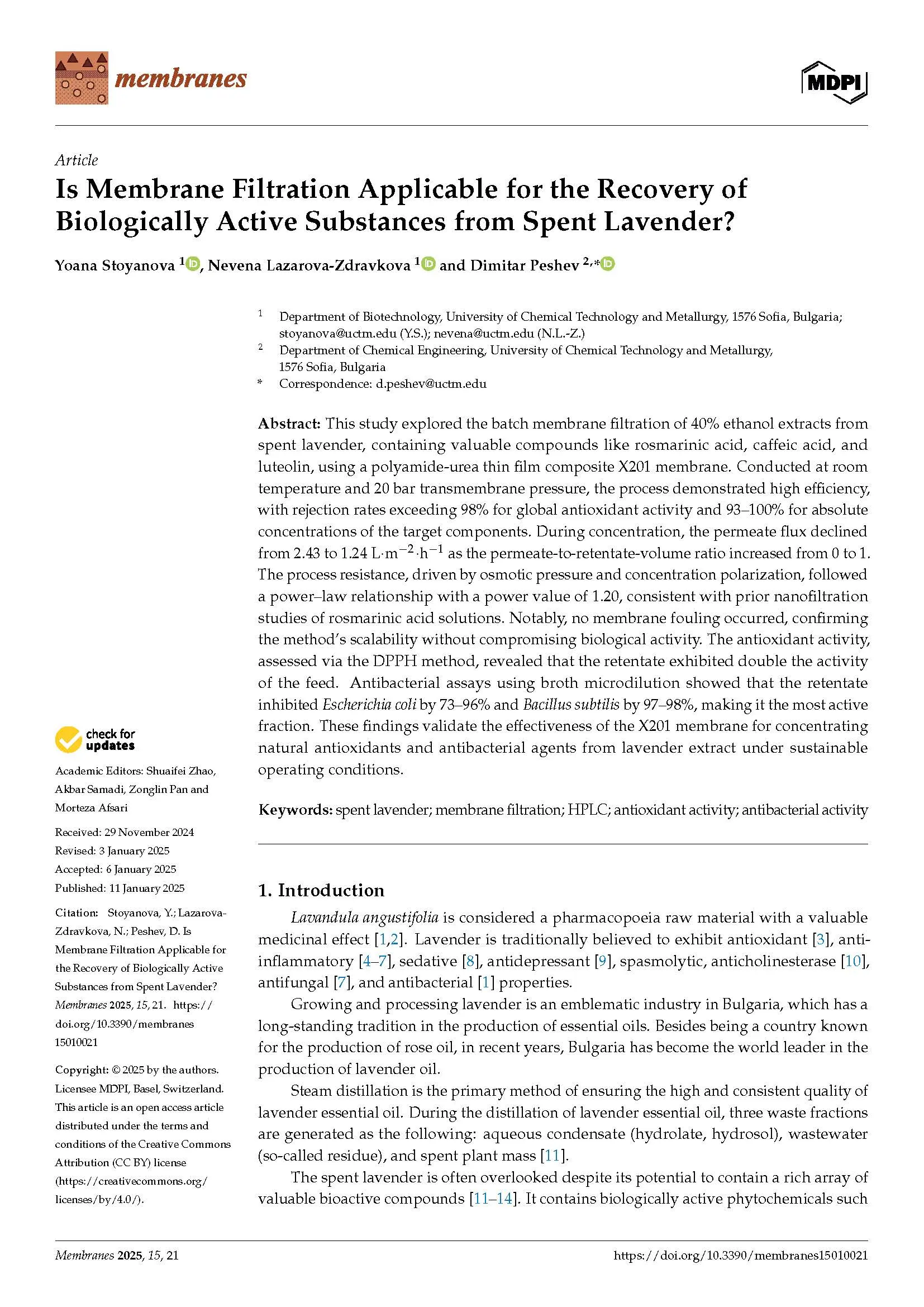
Stoyanova, Yoana; Lazarova-Zdravkova, Nevena; Peshev, Dimitar
Is Membrane Filtration Applicable for the Recovery of Biologically Active Substances from Spent Lavender? Journal Article
In: Membranes , vol. 15, iss. 1, no. 21, 2025.
Abstract | Links | BibTeX | Етикети: Journal Article
@article{nokey,
title = {Is Membrane Filtration Applicable for the Recovery of Biologically Active Substances from Spent Lavender?},
author = {Yoana Stoyanova and Nevena Lazarova-Zdravkova and Dimitar Peshev},
editor = {Shuaifei Zhao and Akbar Samadi and Zonglin Pan and Morteza Afsari},
url = {http://www.nanoessential.eu/wp-content/uploads/Y.Stoyanova-et-al-membranes-15-00021-v3.pdf},
doi = {https://doi.org/10.3390/membranes15010021},
year = {2025},
date = {2025-01-11},
journal = {Membranes },
volume = {15},
number = {21},
issue = {1},
abstract = {This study explored the batch membrane filtration of 40% ethanol extracts from spent lavender, containing valuable compounds like rosmarinic acid, caffeic acid, and luteolin, using a polyamide-urea thin film composite X201 membrane. Conducted at room temperature and 20 bar transmembrane pressure, the process demonstrated high efficiency, with rejection rates exceeding 98% for global antioxidant activity and 93–100% for absolute concentrations of the target components. During concentration, the permeate flux declined from 2.43 to 1.24 L·m−2·h−1 as the permeate-to-retentate-volume ratio increased from 0 to 1. The process resistance, driven by osmotic pressure and concentration polarization, followed a power–law relationship with a power value of 1.20, consistent with prior nanofiltration studies of rosmarinic acid solutions. Notably, no membrane fouling occurred, confirming the method’s scalability without compromising biological activity. The antioxidant activity, assessed via the DPPH method, revealed that the retentate exhibited double the activity of the feed. Antibacterial assays using broth microdilution showed that the retentate inhibited Escherichia coli by 73–96% and Bacillus subtilis by 97–98%, making it the most active fraction. These findings validate the effectiveness of the X201 membrane for concentrating natural antioxidants and antibacterial agents from lavender extract under sustainable operating conditions.},
keywords = {Journal Article},
pubstate = {published},
tppubtype = {article}
}
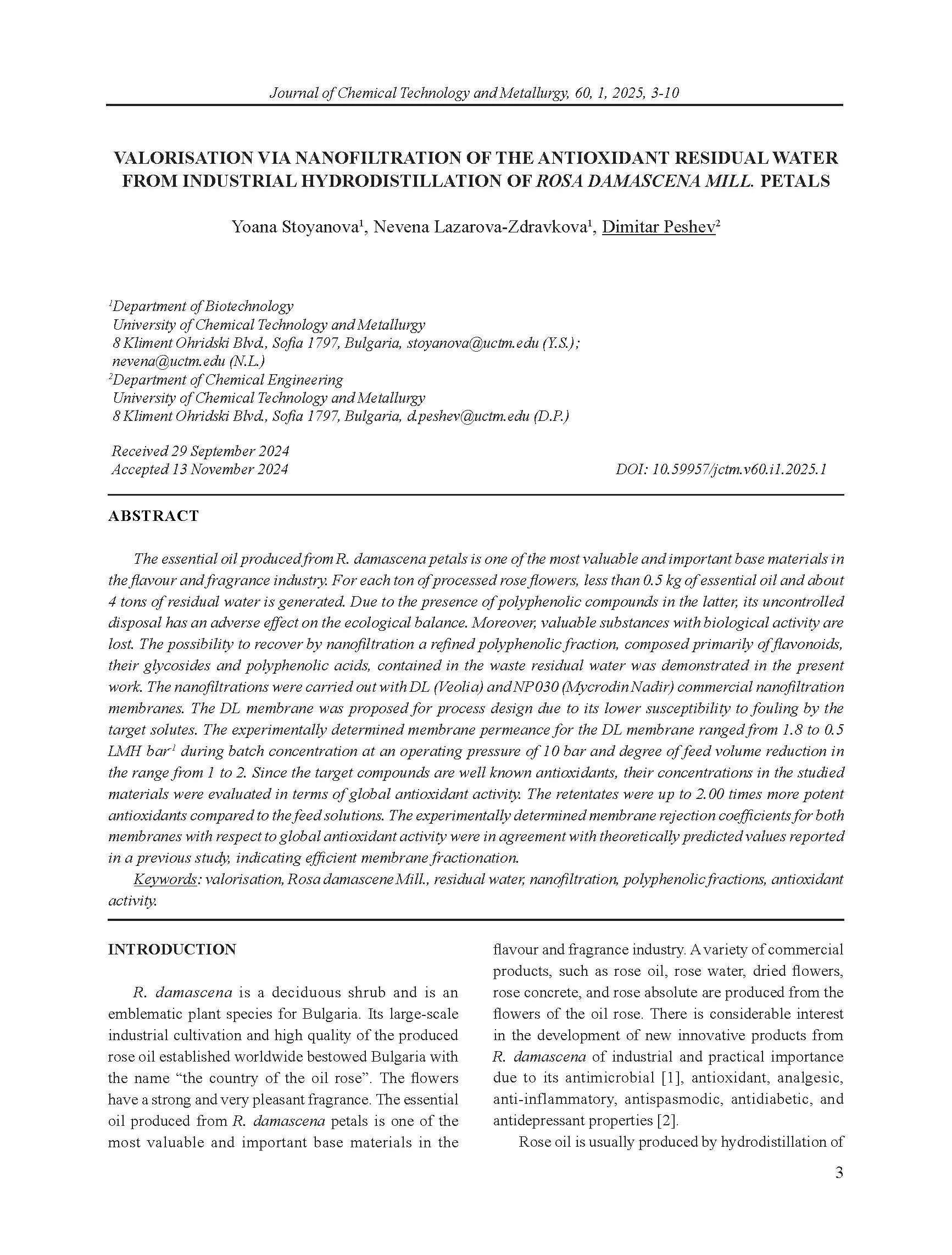
Stoyanova, Yoana; Lazarova-Zdravkova, Nevena; Peshev, Dimitar
VALORISATION VIA NANOFILTRATION OF THE ANTIOXIDANT RESIDUAL WATER FROM INDUSTRIAL HYDRODISTILLATION OF ROSA DAMASCENA MILL. PETALS Journal Article
In: Journal of Chemical Technology and Metallurgy, vol. 60, iss. 1, pp. 3-10, 2025, ISSN: 1314-7471.
Abstract | Links | BibTeX | Етикети: Journal Article
@article{nokey,
title = {VALORISATION VIA NANOFILTRATION OF THE ANTIOXIDANT RESIDUAL WATER FROM INDUSTRIAL HYDRODISTILLATION OF ROSA DAMASCENA MILL. PETALS},
author = {Yoana Stoyanova and Nevena Lazarova-Zdravkova and Dimitar Peshev},
editor = {Prof. Dr. Dancho Danalev and Assoc. Prof. Dr. Angelina Popova},
url = {http://www.nanoessential.eu/wp-content/uploads/JCTM_2025_60_1_24-119_p3-10.pdf},
doi = {10.59957/jctm.v60.i1.2025.1},
issn = {1314-7471},
year = {2025},
date = {2025-01-06},
journal = {Journal of Chemical Technology and Metallurgy},
volume = {60},
issue = {1},
pages = {3-10},
abstract = {The essential oil produced from R. damascena petals is one of the most valuable and important base materials in the flavour and fragrance industry. For each ton of processed rose flowers, less than 0.5 kg of essential oil and about 4 tons of residual water is generated. Due to the presence of polyphenolic compounds in the latter, its uncontrolled disposal has an adverse effect on the ecological balance. Moreover, valuable substances with biological activity are lost. The possibility to recover by nanofiltration a refined polyphenolic fraction, composed primarily of flavonoids, their glycosides and polyphenolic acids, contained in the waste residual water was demonstrated in the present work. The nanofiltrations were carried out with DL (Veolia) and NP030 (Mycrodin Nadir) commercial nanofiltration membranes. The DL membrane was proposed for process design due to its lower susceptibility to fouling by the target solutes. The experimentally determined membrane permeance for the DL membrane ranged from 1.8 to 0.5 LMH bar-1 during batch concentration at an operating pressure of 10 bar and degree of feed volume reduction in the range from 1 to 2. Since the target compounds are well known antioxidants, their concentrations in the studied materials were evaluated in terms of global antioxidant activity. The retentates were up to 2.00 times more potent antioxidants compared to the feed solutions. The experimentally determined membrane rejection coefficients for both membranes with respect to global antioxidant activity were in agreement with theoretically predicted values reported in a previous study, indicating efficient membrane fractionation.},
keywords = {Journal Article},
pubstate = {published},
tppubtype = {article}
}
2022
Chilev, Chavdar; Simeonov, Evgeni; Dimitrova, Borislava; Yonkova, Velislava; Pietsch, Swantje; Heinrich, Stefan; Peshev, Dimitar
In: Journal of Chemical Technology and Metallurgy, vol. 57, iss. 3, pp. 522-532, 2022, ISSN: 1314-7471.
Abstract | Links | BibTeX | Етикети: Journal Article
@article{nokey,
title = {Valorization of waste lavender residue from the essential oil industry for production of rosmarinic acid – a study on the solid-liquid extraction},
author = {Chavdar Chilev and Evgeni Simeonov and Borislava Dimitrova and Velislava Yonkova and Swantje Pietsch and Stefan Heinrich and Dimitar Peshev},
editor = {Bogdana Koumanova},
url = {http://www.nanoessential.eu/wp-content/uploads/11_21-176_br_3_pp_522-532.pdf},
issn = {1314-7471},
year = {2022},
date = {2022-01-25},
urldate = {2022-01-25},
journal = {Journal of Chemical Technology and Metallurgy},
volume = {57},
issue = {3},
pages = {522-532},
abstract = {The possibility for valorization of the waste lavender residue from the essential oil industry via solvent extraction was studied. The plant residue of Lavandula angustifolia, from which the lavender oil is extracted through steam distillation, contains Key Biologically Active Components (KBAC) such as: rosmarinic acid, caffeic acid, luteolin. The feasibility of the solvent extraction for their isolation was assessed by comparison of the kinetics and equilibrium of extraction of KBAC from spent and raw plant material (collected from the same batch before the steam distillation) using different solvent compositions. The parameters of the extraction process were experimentally and numerically optimized. To determine the most efficient solvent, two pure and two mixed solvents were tested: pure water, 99.9% Ethanol and their mixtures – (40% and 60% Ethanol). Using 40% ethanol as extraction solvent resulted in maximum recovery of KBAC. A mathematical model for the solid-liquid extraction from lavender materials was developed. The values of the model parameters were determined using the Regular regime method. A four-parameter empirical model for prediction of the effective diffusivity, D_eff, was also applied. The model adequacy was experimentally verified. Based on the theoretical and experimental results KBAC recovery the following extraction conditions were recommended: extraction time - 30min, temperature - 30℃, liquid-solid ratio - 0.01 m^3⁄kg, and 40% Ethanol as an extraction solvent
Keywords: solid-liquid extraction, kinetics, lavender, modeling, rosmarinic acid, essential oil.
Acknowledgements: This work was supported by the Bulgarian National Science Fund (contract KP-06-H37/14).},
keywords = {Journal Article},
pubstate = {published},
tppubtype = {article}
}
Keywords: solid-liquid extraction, kinetics, lavender, modeling, rosmarinic acid, essential oil.
Acknowledgements: This work was supported by the Bulgarian National Science Fund (contract KP-06-H37/14).
2021
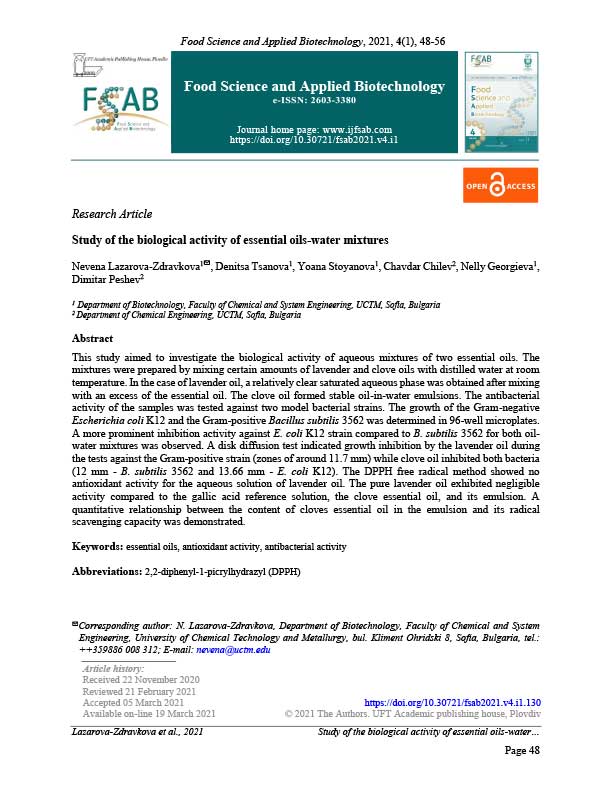
Lazarova-Zdravkova, Nevena; Tsanova, Denitsa; Stoyanova, Yoana; Chilev, Chavdar; Georgieva, Nelly; Peshev, Dimitar
Study of the biological activity of essential oils-water mixtures Journal Article
In: Food Science and Applied Biotechnology, vol. 4, no. 1, pp. 48-56, 2021.
Abstract | Links | BibTeX | Етикети: Journal Article
@article{Lazarova-Zdravkova2021,
title = {Study of the biological activity of essential oils-water mixtures},
author = {Nevena Lazarova-Zdravkova and Denitsa Tsanova and Yoana Stoyanova and Chavdar Chilev and Nelly Georgieva and Dimitar Peshev},
url = {https://www.ijfsab.com/index.php/fsab/article/view/130/128},
year = {2021},
date = {2021-03-19},
urldate = {2021-03-19},
journal = {Food Science and Applied Biotechnology},
volume = {4},
number = {1},
pages = {48-56},
abstract = {This study aimed to investigate the biological activity of aqueous mixtures of two essential oils. The mixtures were prepared by mixing certain amounts of lavender and clove oils with distilled water at room temperature. In the case of lavender oil, a relatively clear saturated aqueous phase was obtained after mixing with an excess of the essential oil. The clove oil formed stable oil-in-water emulsions. The antibacterial activity of the samples was tested against two model bacterial strains. The growth of the Gram-negative Escherichia coli K12 and the Gram-positive Bacillus subtilis 3562 was determined in 96-well microplates. A more prominent inhibition activity against E. coli K12 strain compared to B. subtilis 3562 for both oil-water mixtures was observed. A disk diffusion test indicated growth inhibition by the lavender oil during the tests against the Gram-positive strain (zones of around 11.7 mm) while clove oil inhibited both bacteria (12 mm - B. subtilis 3562 and 13.66 mm - E. coli K12). The DPPH free radical method showed no antioxidant activity for the aqueous solution of lavender oil. The pure lavender oil exhibited negligible activity compared to the gallic acid reference solution, the clove essential oil, and its emulsion. A quantitative relationship between the content of cloves essential oil in the emulsion and its radical scavenging capacity was demonstrated.},
keywords = {Journal Article},
pubstate = {published},
tppubtype = {article}
}
2020
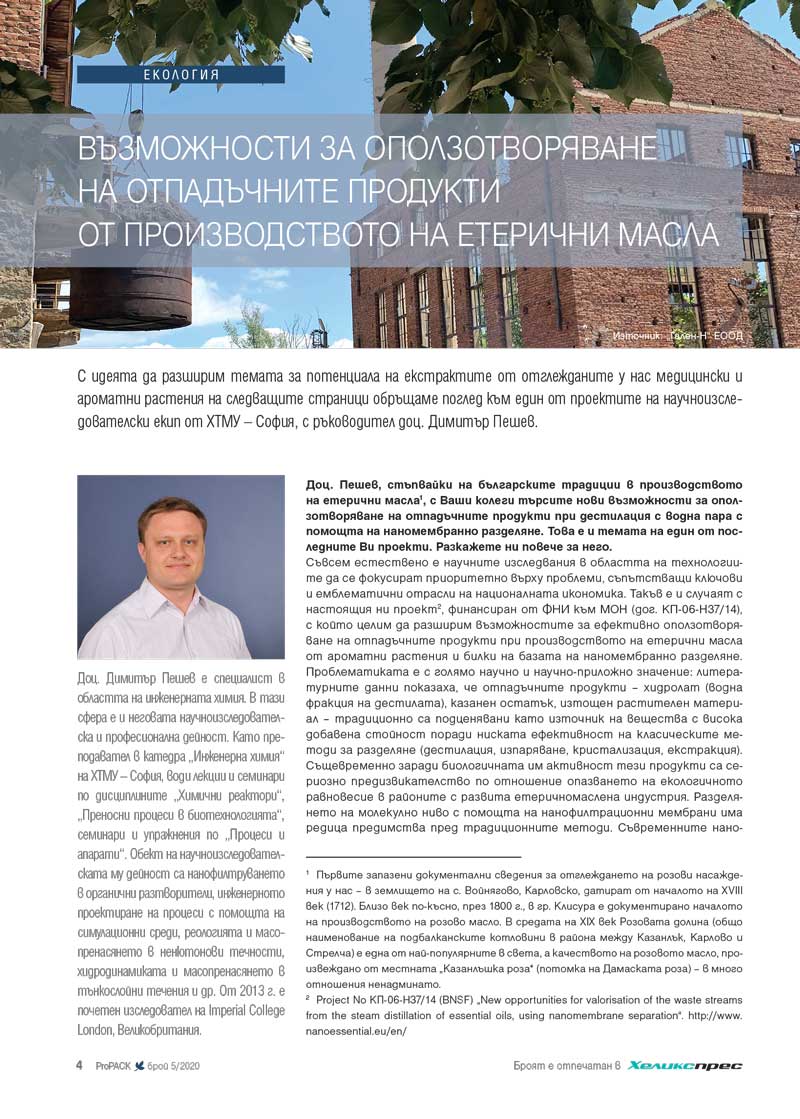
Пешев, Д.
Възможности за оползотворяване на отпадъчните продукти от производството на етерични масла Journal Article
In: Полиграфия, vol. ПроПак, no. 5, pp. 4-7, 2020, ISSN: 0204-9953.
Links | BibTeX | Етикети: Journal Article
@article{D.Peshev2020b,
title = {Възможности за оползотворяване на отпадъчните продукти от производството на етерични масла},
author = {Д. Пешев},
editor = {Е. Николова},
url = {http://www.nanoessential.eu/wp-content/uploads/Peshev_ProPack_Issue_5x2020.pdf},
issn = {0204-9953},
year = {2020},
date = {2020-10-31},
urldate = {2020-10-31},
journal = {Полиграфия},
volume = {ПроПак},
number = {5},
pages = {4-7},
keywords = {Journal Article},
pubstate = {published},
tppubtype = {article}
}
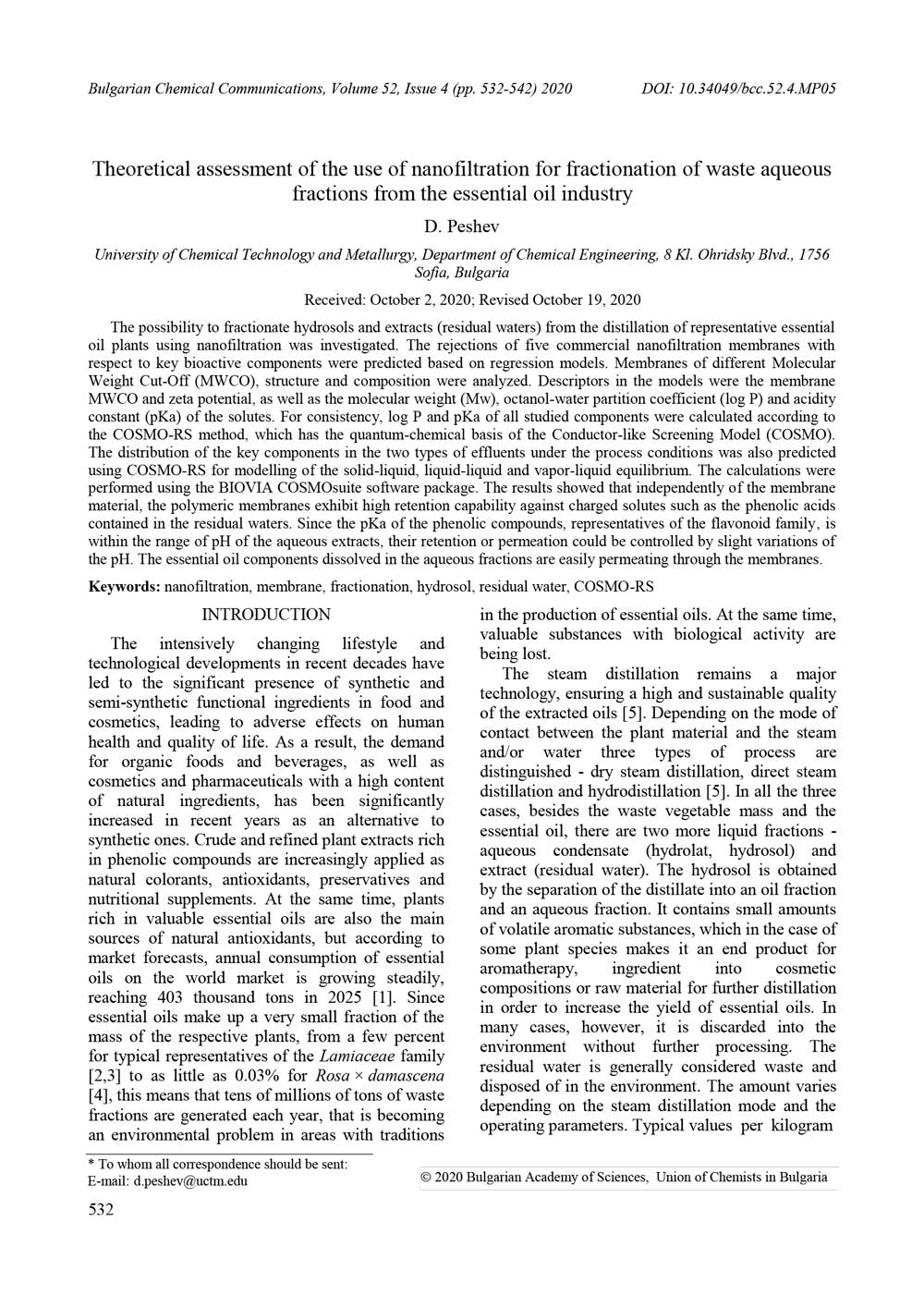
D.Peshev,
Theoretical assessment of the use of nanofiltration for fractionation of waste aqueous fractions from the essential oil industry Journal Article
In: Bulgarian Chemical Communications, vol. 52,, no. 4, pp. 532-542, 2020.
Abstract | Links | BibTeX | Етикети: Journal Article
@article{D.Peshev2020,
title = {Theoretical assessment of the use of nanofiltration for fractionation of waste aqueous fractions from the essential oil industry},
author = {D.Peshev},
url = {http://www.nanoessential.eu/wp-content/uploads/BCC-52-4-2020-532-542-Peshev-MP05-1.pdf},
doi = {10.34049/bcc.52.4.MP05},
year = {2020},
date = {2020-10-19},
urldate = {2020-10-19},
journal = {Bulgarian Chemical Communications},
volume = {52,},
number = {4},
pages = {532-542},
abstract = {The possibility to fractionate hydrosols and extracts (residual waters) from the distillation of representative essential oil plants using nanofiltration was investigated. The rejections of five commercial nanofiltration membranes with respect to key bioactive components were predicted based on regression models. Membranes of different Molecular Weight Cut-Off (MWCO), structure and composition were analyzed. Descriptors in the models were the membrane MWCO and zeta potential, as well as the molecular weight (Mw), octanol-water partition coefficient (log P) and acidity constant (pKa) of the solutes. For consistency, log P and pKa of all studied components were calculated according to the COSMO-RS method, which has the quantum-chemical basis of the Conductor-like Screening Model (COSMO). The distribution of the key components in the two types of effluents under the process conditions was also predicted using COSMO-RS for modelling of the solid-liquid, liquid-liquid and vapor-liquid equilibrium. The calculations were performed using the BIOVIA COSMOsuite software package. The results showed that independently of the membrane material, the polymeric membranes exhibit high retention capability against charged solutes such as the phenolic acids contained in the residual waters. Since the pKa of the phenolic compounds, representatives of the flavonoid family, is within the range of pH of the aqueous extracts, their retention or permeation could be controlled by slight variations of the pH. The essential oil components dissolved in the aqueous fractions are easily permeating through the membranes.},
keywords = {Journal Article},
pubstate = {published},
tppubtype = {article}
}